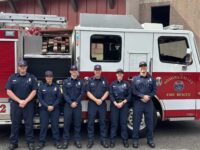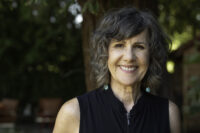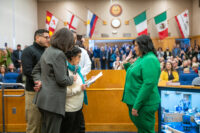It started as a high-quality office building project, then turned “green” when the owners realized, close to the start of construction, that their plan could qualify for LEED certification. Jeffrey Freiburg, one of the owners who is managing the project, calls it a decision that’s good for the environment and the group of Sonomans who are investing $5.9 million for the long haul.
The two-building complex, south of the post office on Broadway, will earn a silver LEED (Leadership in Energy and Environmental Design) rating from the U.S. Green Building Council (USGBC), a Washington, D.C.-based non-profit organization committed to expanding sustainable building practices. When completed and fully occupied, the buildings may qualify for a gold rating, the second highest, based on a point rating system.
As Freiburg explains it, the group’s goal — to build commercial space with low maintenance costs that it will “own for generations” — fits LEED requirements and benefits the owners, because it will attract tenants who will pay higher rents and stay for the long-term. He adds that sustainable building is good for the community and hopes it will be an example for others.
Mark Molofsky, head of Molofsky Builders, the general contractor and a member of USGBC, suggested seeking LEED certification in the summer of 2005, after the project was underway. One of the first steps was to carefully dismantle the old two-story residential structure at 635 Broadway, next to the post office, so that much of the old material could be reused or recycled.
Local architect Adrian Martinez had designed the buildings to take advantage of the climate, with balconies for access to the outdoors and windows that open for lots of air and light. The only functional change required by LEED was lower-flow toilets, at a cost of $3,500. The major expense, over $100,000, was to document the use of materials with lower environmental impact, because the project hadn’t started out to be certified. (If it had, documentation would have cost only $35,000.)
Freiburg gives some examples of how the buildings satisfy LEED. Exterior lights limit pollution by not letting the light shine above the horizon, and fixtures throughout the buildings use low-power fluorescents or LEDs. Lumber comes from sustainable sources, including plywood made from bamboo, called Plyboo.
The concrete in the foundations uses fly ash to replace some of the cement, a material that creates lots of pollution when it’s made. To use less concrete, the three-story stucco building at 10 Maple Street rests on a post-tension slab foundation, which has interior cables that were tightened for extra strength, reducing its thickness by two-thirds.
Photovoltaic panels that cover the roofs of both buildings could meet 50 percent or more of the power needs, depending on the type of tenants that move in.
LEED buildings also can reduce their carbon footprint by using materials that come from less than 500 miles away. In this case, the roof tiles were made in Fresno and the carpet in Los Angeles. The buildings will have special parking and a shower for bicyclists, and spots for fuel-efficient cars, all LEED requirements, according to Freiburg. And the site has no water-guzzling lawn and all landscaping is drought-resistant, maintained by a drip irrigation system.
The architect gave equal importance to the aesthetic impact of the buildings. Martinez wanted them to look as if they’ve always been here. The two-story 635 Broadway structure, built in the California Craftsman style, fits the character of the buildings to the south, most of which are residences that have been converted to commercial use. The Sonoma League for Historic Preservation recently gave the building special recognition at its 30th Annual Preservation Awards for being “green,” and for adding “richness to Sonoma and the Valley.”
The three-story 10 Maple Street structure, built in what Martinez calls California Mediterranean style, includes public art inside and out by local artists John Curry and Scott Long. Curry created two-layered metal murals for the outside and a free-standing sculpture at the entrance. Tenants and visitors can see the waterfall mural Long painted in the elevator shaft as they ride up and down.
Freiburg expects the buildings to be ready for occupancy at the end of February.
Office complex-to-be up for official sustainable building status
More from What's HappeningMore posts in What's Happening »




